White armor
OVERVIEW
What is leukonychia?
Leukonychia, also known as white nails or white nail syndrome, refers to a condition where fingernails or toenails appear white.
Leukonychia is related to changes in the nail plate or the nail bed beneath it, manifesting as white spots, patches, or streaks on the nails.
When caused by abnormalities in the nail plate, it is called "true leukonychia," which can be further classified into punctate leukonychia, longitudinal leukonychia, partial leukonychia, and total leukonychia based on appearance.
If the nail plate is normal but the nail bed is affected, it is called "apparent leukonychia."
Different types have varying causes, which may include trauma, infection, genetics, or systemic diseases:
- Punctate leukonychia is caused by minor trauma and is commonly seen in children.
- Longitudinal or partial leukonychia is usually associated with other diseases and is more common in adults.
- Total leukonychia is generally hereditary and relatively rare.
- Apparent leukonychia is often caused by nail bed edema, which may be linked to internal medical conditions.
SYMPTOMS
What are the symptoms of leukonychia?
It primarily causes changes in nail color, presenting as visible white spots, patches, or streaks of varying sizes. There are five common types.
-
Punctate leukonychia: Irregular white spots on the nails that do not fade when pressed.
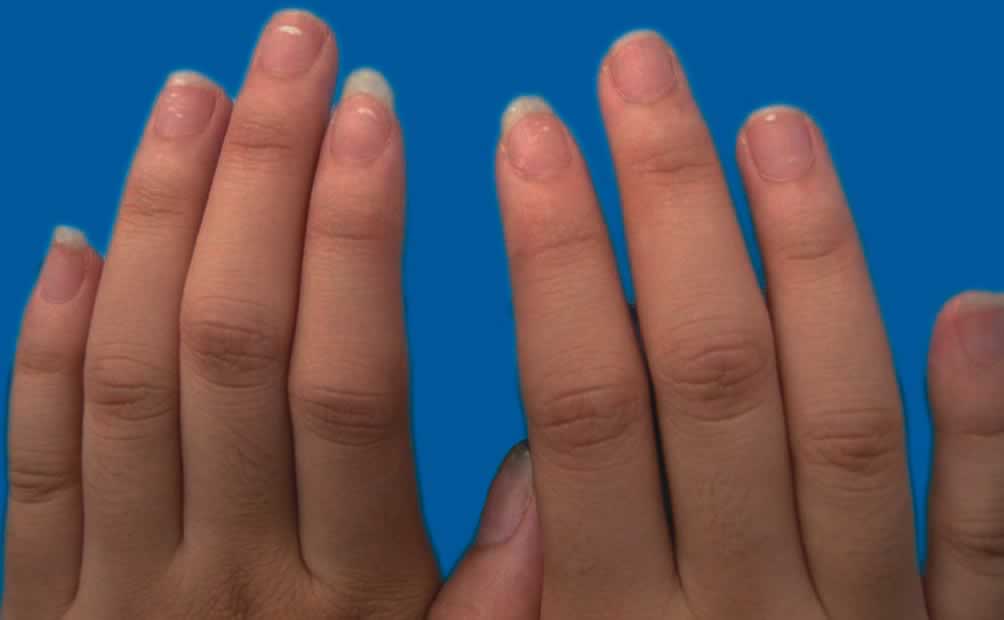
(Image source: Practical Color Atlas of Dermatology and Venereology) -
Longitudinal or transverse leukonychia: White streaks on the nails, either horizontal or vertical, single or multiple, varying in width, and not fading when pressed.
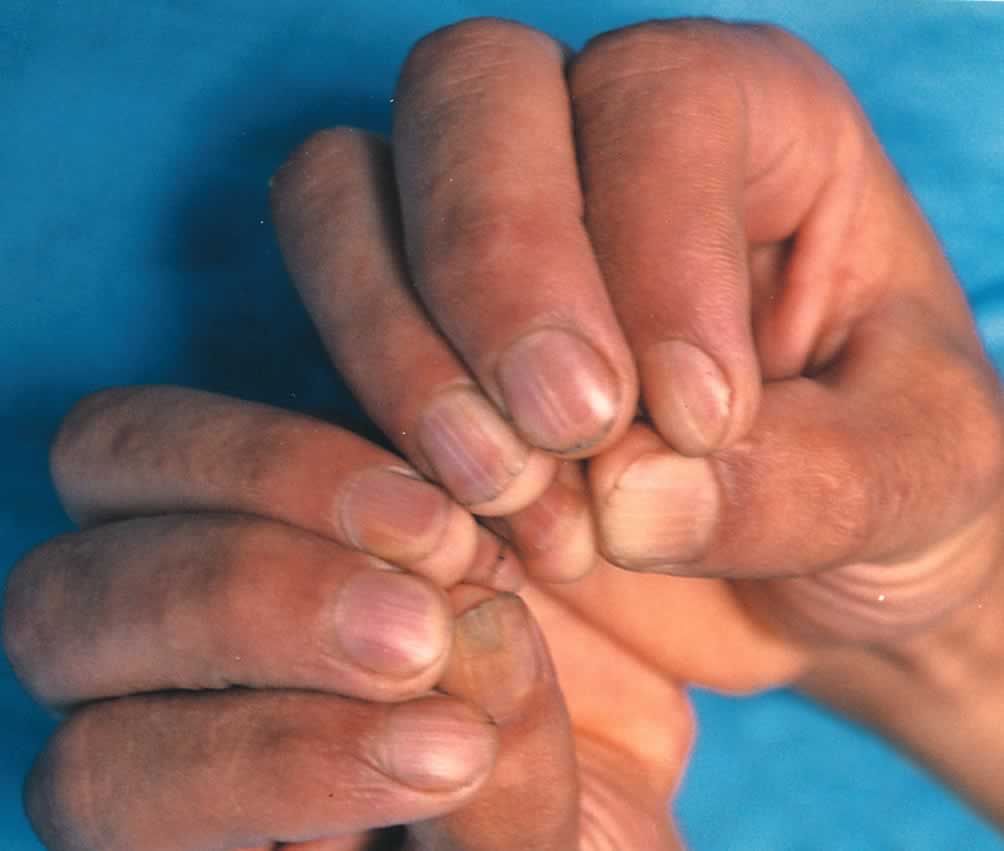
(Image source: Practical Color Atlas of Dermatology and Venereology)
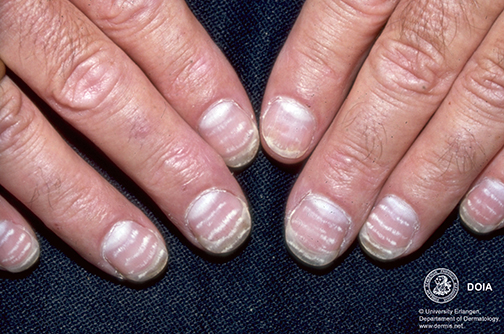
(Image source: Nail Disorders Overview. UpToDate Clinical Advisor) -
Partial leukonychia: Partial whitening of the nail, appearing as white patches that do not fade when pressed.

(Image source: Nail Disorders Overview. UpToDate Clinical Advisor) -
Total leukonychia: The entire nail turns white and does not fade when pressed.
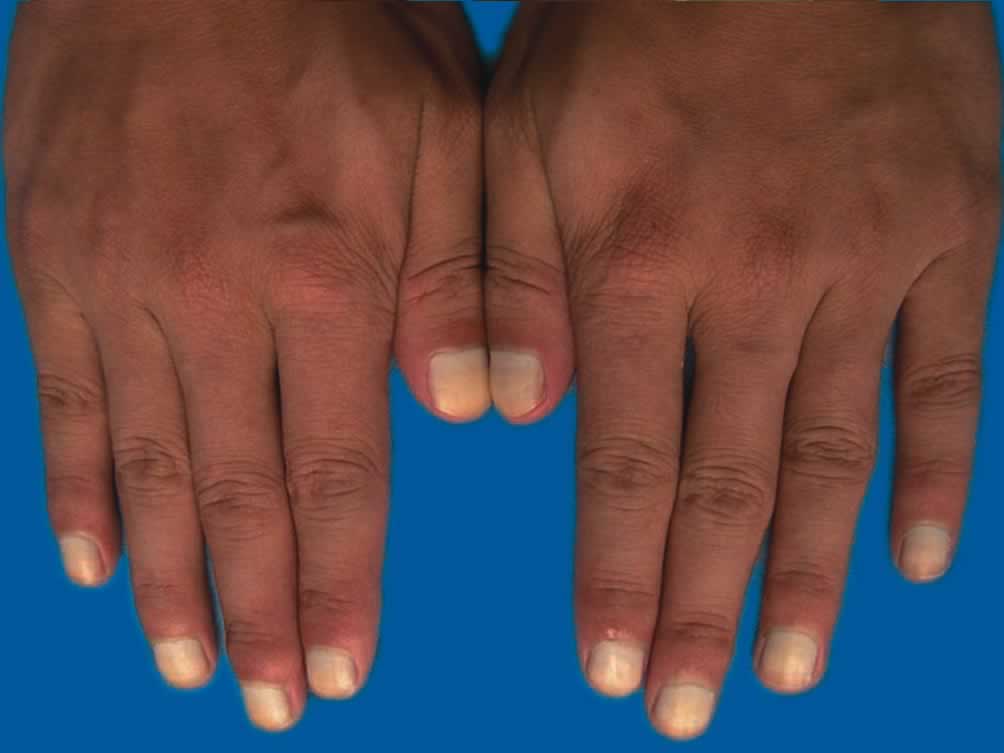
(Image source: Practical Color Atlas of Dermatology and Venereology) -
Apparent leukonychia: White discoloration visible through the transparent nail plate, which fades when pressed. Apparent leukonychia can be further classified into Muehrcke's nails, half-and-half nails, and Terry's nails.
-
Muehrcke's nails: Multiple horizontal white bands on the nails, parallel to the lunula.

Muehrcke's nails, Image source: https://healthjade.net/muehrckes-lines/ -
Terry's nails: In Terry's nails, the distal 1–2 mm of the nail appears normal pink, while the entire nail plate or proximal part appears white due to changes in the nail bed.
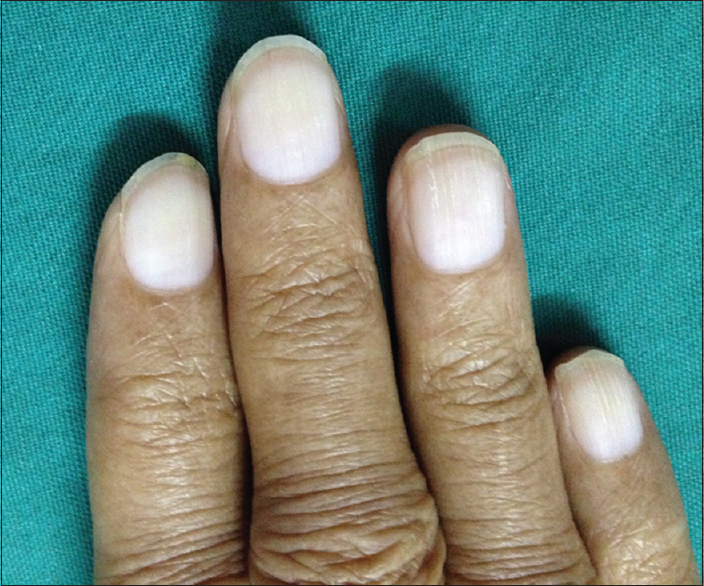
Terry's nails, Image source: https://indianjnephrol.org/ -
Half-and-half nails: The proximal half of the nail appears white, while the distal half appears red, pink, or brown, with a clear boundary between them.
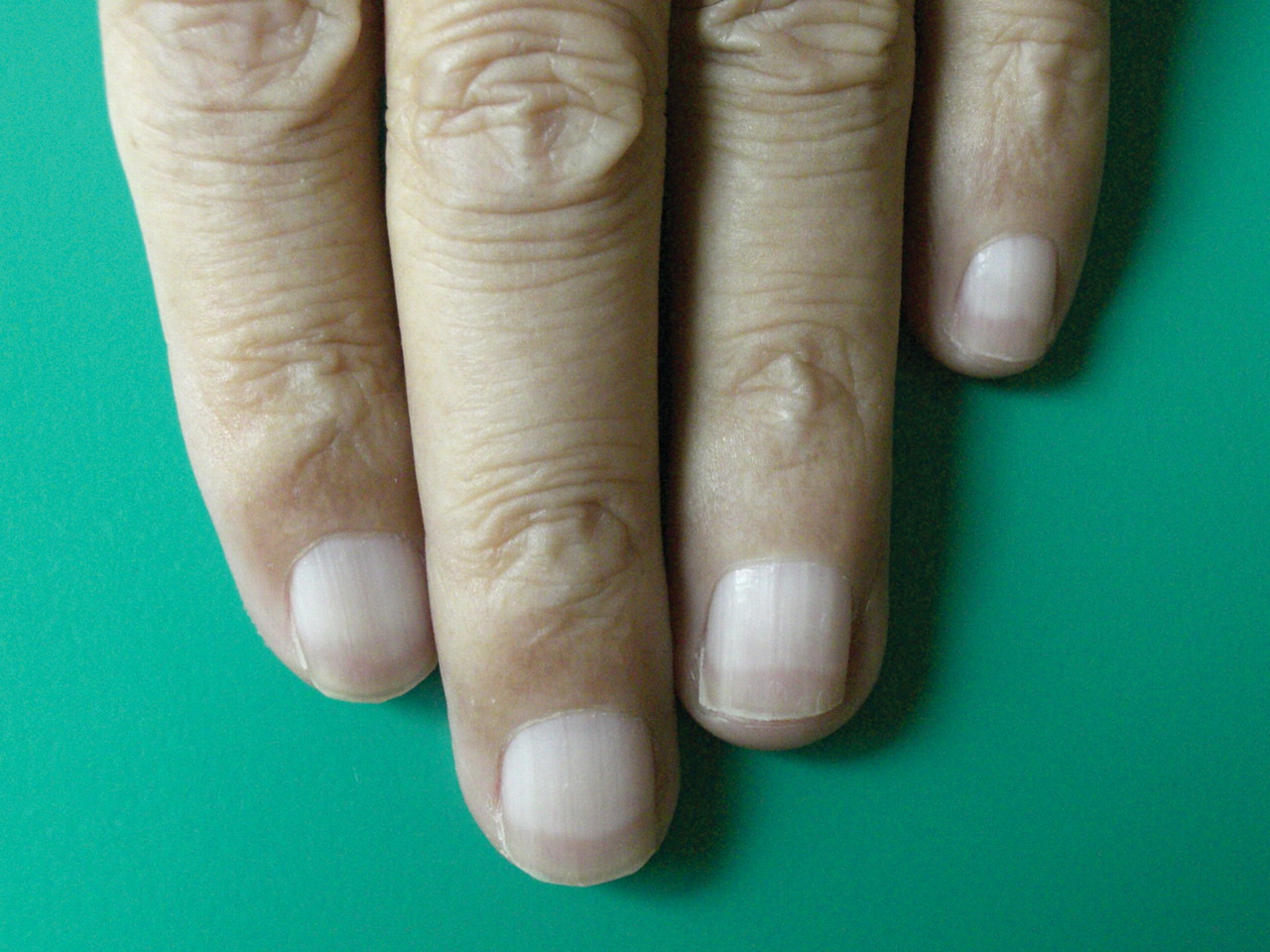
Half-and-half nails, Image source: https://www.cmaj.ca/content/180/6/687
-
CAUSES
What Causes Leukonychia?
The causes vary depending on the type of leukonychia:
-
Punctate Leukonychia: Commonly seen in otherwise healthy individuals.
-
More prevalent in children, often caused by trauma or nail-biting, unrelated to parasitic infections or micronutrient deficiencies. It also frequently occurs in people who engage in manual labor, housework, or frequent manicures.
-
Fungal infections, syphilis, and systemic diseases (e.g., typhoid fever, nephritis) may also cause punctate leukonychia. It can appear symmetrically on both hands (sympathetic leukonychia).
-
-
Longitudinal Leukonychia: Causes may include hereditary factors, trauma, or systemic diseases.
-
Transverse lines are often trauma-related, such as excessive nail trimming, improper manicures damaging the proximal nail, or pressure from footwear.
-
Regular white transverse lines on all nails may indicate arsenic or thallium poisoning.
-
Longitudinal white lines on the nail plate or nail bed may suggest Darier’s disease or onychopapilloma.
-
Also associated with systemic conditions like HIV infection, Kawasaki disease, pellagra, renal failure, heart failure, and Hodgkin’s lymphoma.
-
-
Partial Leukonychia: Sometimes idiopathic (cause unknown), or linked to onychomycosis, trauma, or leprosy.
-
Total Leukonychia:
-
Also called "diffuse leukonychia," possibly hereditary. It may occur in syndromes involving total leukonychia, multiple sebaceous cysts, and kidney stones, or accompany deafness. Hereditary total leukonychia, caused by PLCD1 gene mutations, presents as porcelain-white nails.
-
Other systemic conditions like nephrotic syndrome, liver failure, protein malabsorption, or protein-losing enteropathy may also cause it.
-
Sulfonamide antibiotics can induce total leukonychia as a side effect.
-
-
Apparent Leukonychia: Results from nail bed abnormalities, where white discoloration visible through the transparent nail plate fades upon pressure. Causes include chemotherapy drugs or systemic diseases like hypoalbuminemia.
-
Muehrcke’s nails may arise from hypoalbuminemia or nephrotic syndrome.
-
Terry’s nails are seen in cirrhosis, chronic congestive heart failure, adult diabetes, and the elderly.
-
Half-and-half nails: Common in hemodialysis patients, chronic kidney disease, or post-kidney transplant.
-
Is Leukonychia Contagious?
Most types are not contagious. Exceptions include onychomycosis (fungal nail infection), transmitted through direct contact (touching affected nails) or indirect contact (sharing items like slippers or nail clippers).
Is Leukonychia Hereditary?
Some forms have genetic links. For example, total leukonychia caused by PLCD1 gene mutations follows an autosomal dominant inheritance pattern.
DIAGNOSIS
Is Examination Necessary for Diagnosing Leukonychia?
Leukonychia can be diagnosed based on typical nail manifestations such as white spots, patches, or streaks.
Certain types, particularly linear, partial, or total leukonychia accompanied by other abnormal symptoms, often indicate underlying primary diseases. In such cases, consultation, examination, and treatment in relevant medical departments are required.
TREATMENT
Which department should leukonychia patients visit?
Primarily dermatology, but internal medicine if systemic disease is suspected.
How is leukonychia treated?
Most leukonychia cases are harmless and primarily a cosmetic concern—treatment depends on personal preference. If caused by underlying conditions, the primary disease requires active treatment.
Patients typically visit dermatology first. Dermatologists will rule out or treat skin-related causes before potential referral to internal medicine for evaluation and management of systemic conditions.
DIET & LIFESTYLE
What should be paid attention to in the diet for leukonychia?
For leukonychia without underlying diseases, there are no special dietary restrictions. A healthy and balanced diet is sufficient.
What should be paid attention to in daily life for leukonychia?
For leukonychia without underlying diseases, there are no special lifestyle precautions. Maintaining a healthy lifestyle is sufficient.
What should be paid attention to if leukonychia has an underlying disease?
If leukonychia is clearly caused by an underlying disease, follow the dietary and activity guidelines for that primary condition in daily life.
PREVENTION
How to prevent leukonychia?
There are many primary diseases that cause leukonychia, and there are no specific preventive measures.
If discomfort symptoms are noticed in daily life, it is recommended to seek medical attention promptly and actively cooperate with treatment to prevent the condition from worsening to the point of developing leukonychia.
Later, targeted protective measures can be taken based on the specific cause. For example:
- If it is traumatic punctate leukonychia, avoid or correct finger-biting habits and prevent other mechanical injuries such as squeezing or impact;
- If it is onychomycosis caused by fungal infection, avoid direct contact with others' skin and refrain from sharing personal items.